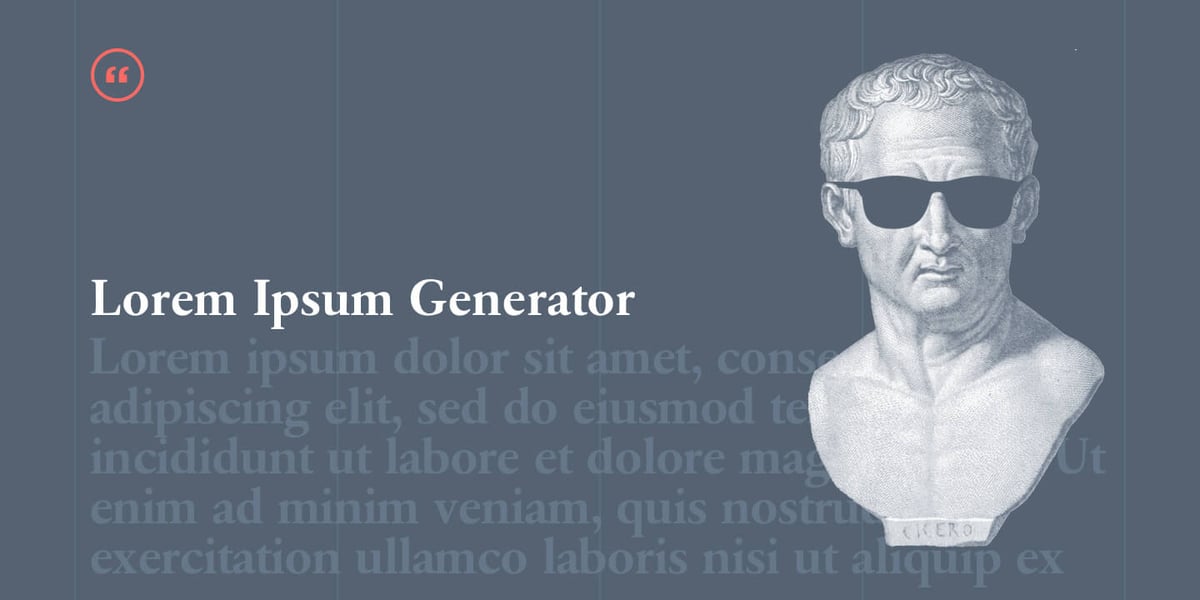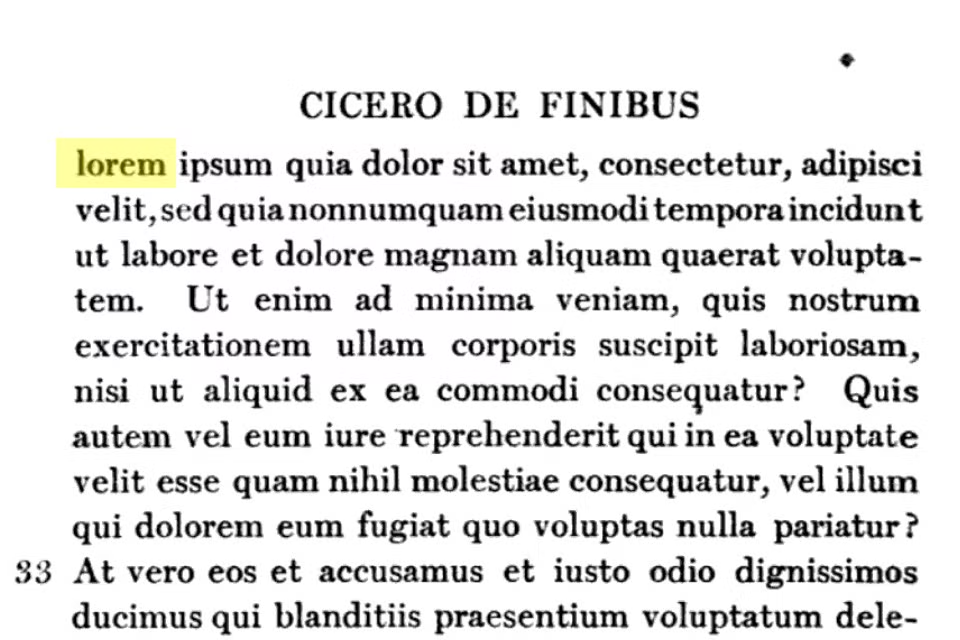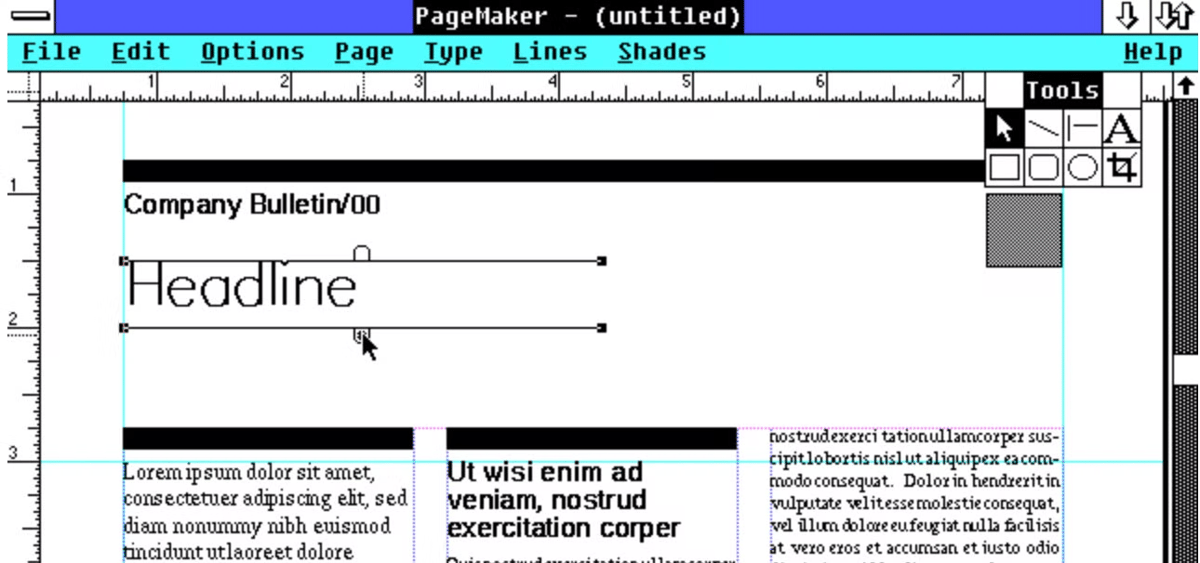kottke.org posts about software

“Lorem ipsum” is a shorthand for placeholder text, usually beginning with this not-quite-meaningful-Latin phrase. Many folk genealogies date the practice to the Latin-loving Renaissance humanists, and who knows? Maybe Aldus Manutius did have some dummy Latin that he liked to use to test a page design. But it probably wasn’t the same text we use today, and Aldus himself only enters the story in a marginal way.
Jack Shepherd argues persuasively for a much more recent lorem ipsum origin story.
The source text is definitely Cicero, although it’s two mishmashed quotes from De Finibus Bonorum et Malorum (About the Ends of Good and Evil) with words cut in half:

You’ll notice that this image, from the Loeb Classical Library 1914 opposing-face translation of Cicero’s work, doesn’t cut off “delorem ipsum,” or rather it does: this page is the second half of the cut. And that’s one clue that we have that this particular truncation of the text is a twentieth century practice, not a fifteenth century one.
The earliest example that anyone seems to have been able to find of Random Selections of the 1914 Loeb Facing Translation of Sections 1.10.32 and 1.10.33 of Cicero’s De Finibus Used as Dummy Text (aka, mercifully, Lorem Ipsum) is from the 1960s. At the time, if you wanted to mock up an ad or a flier for a punk show and you didn’t have a bunch of bespoke font settings on your Imperial Model 70 typewriter, your best bet was a British company called Letraset, which sold adhesive transfer sheets with different typefaces.
Letraset used Lorem Ipsum in their advertisements, and the layout-design software company Aldus (maker of the popular PageMaker layout tool) duplicated the practice in the ’80s, which is presumably the origin point of ChatGPT’s tall tale about Aldus Manutius using Lorem Ipsum in the 16th Century.

You might feel a little deflated by this revelation. You mean, that’s it? It’s been software all along? We don’t stand in a noble tradition of humanist lettersetters?
Ah, but the thing is we do! Nothing screams “Renaissance humanism” more than inventing a practice and then assigning it a venerable pseudo-archaic origin. Imitation here is genuinely the sincerest form of flattery. This is perfect.
Hi, everybody! Tim Carmody here, guest-hosting for Jason this week.
There are fewer third-party Twitter applications in active development than there used to be, since Twitter built its own clients, clamped down on apps that “replicate Twitter’s core user experience,” limited the number of new user tokens third parties could get, and otherwise kinda spiked the well.
But there are still some gems out there, including some I was surprised I’d never heard of. Joanna Geary, Twitter’s head of news in the UK, recently put together a shortlist of 30 third-party webapps useful for journalists. Here are three I’ve been using and enjoying:
- Followerwonk includes a number of useful searching and sorting tools, some free, some paid. I was especially impressed that it can give an inferred gender breakdown of your follows and followers that includes “undetermined” as a category. (A lot of other tools break everything down into male and female, which isn’t a good binary for human bodies, let alone the zoography of Twitter.) Being able to search Twitter bios is useful too.
- TweetBe.at is a list manager. Twitter’s been neglecting lists — on the website “Lists” is even hidden behind an otherwise superfluous “More” button, inside your own profile — but they’re really useful. It’s just that even in the best third-party apps, it’s not easy to add or edit them. This fills that gap.
- My favorite Twitter tool right now is BioIsChanged, which (you might guess) tracks bio and avatar changes for the folks you follow on Twitter. You can see when someone changed jobs, took a new headshot, or otherwise tweaked what they’re about online. What I like best is its customization: you can get new bio notifications in real-time (too much for me!), in daily or weekly digest emails (perfect!), or just whenever you check into the website. I’m getting better at pretending to be superhumanly attentive already.
Two other Twitter tools worth trying that aren’t part of Geary’s list but are worth a look:
I just started with Nuzzel, but it comes highly recommended by Christopher Mims and Lauren Goode, two reporters whose judgment I trust. Like Flipboard and Newsle and a handful of others, it pulls web links from your Twitter and Facebook feeds, sorting them by the most-shared. A good way to see what everybody’s talking about at a glance.
And Happy Friends is a mailbox/outline reader for Twitter that’s hard to explain but fun to use once you get into it. It’s not like anything else out there, which might be the best compliment I can give it.
Update: I missed an app that I’ve been using for so long and so often that I forgot to mention it. ThinkUp, which offers “analytics for humans.” The best thing about ThinkUp are its email “insights” digests, which tell me things like which users I’m talking to most often, whether I’m retweeting too many of my own replies (hint: when I asked you what you name your computers yesterday, I retweeted probably a few too many of your answers), and other little mini-analyses.
I also have to put in a plug for YoruFukurou, my favorite client for Mac. (I hope your tokens don’t run out, YF.) It’s a customizable, high-powered app that handles lists and spam reporting and link and image expansion well, but it doesn’t have that oh-my-god, Ozymandias-watching-30-TV-screens-at-once thing that TweetDeck has. An elegant weapon for a more civilized age.
Adobe has released the beta version of a program called Lightroom (OS X only), a competitor to Apple’s Aperture. Both are pro-level apps for manipulating and organizing digital photos. Here’s the story of Lightroom’s development from one of its developers. (via df)
A list of iPhoto 5 annoyances. I wish iPhoto were as finished a product as iTunes is. (via df?)
Khoi Vinh reports on computer technology in Vietnam. They’re wired for broadband and Windows still dominates.
Adobe is planning on combining Flash Player and Acrobat Reader? As Todd says, “I don’t know about you, but I just got an acrid taste in my mouth”.
Update: John Dowdell notes that Adobe has clarified their position re: the above combination: “we will continue delivering the Flash Player as a small, efficient runtime for content and applications on the web”. (thx, neil)
Shaun Inman’s Mint stats package contains a great easter egg. Just key in the Konami cheat code (up up, down down, left right, left right, b, a) and you’re greeted with a custom graphic. More old school video game-inspired easter eggs on web sites please.
Clive Thompson on Life Hackers in the NY Times. I’d informally heard about the benefit of larger screens on productivity (I feel more productive with a larger screen), but this article describes some study results: “On the bigger screen, people completed the tasks at least 10 percent more quickly - and some as much as 44 percent more quickly.”
The Onion: Project Manager Leaves Suicide PowerPoint Presentation. “We all got Ron’s message loud and clear when that JPEG of his wife wipe-transitioned to a photo of her tombstone”. (via mathowie)
Is PowerPoint responsible for the woes of the Space Shuttle? Well, no, but it’s not helping any. “The deeper problem with the PowerPointing of America — the PowerPointing of the planet, actually — is that the program tends to flatten the most complex, subtle, even beautiful, ideas into tedious, bullet-pointed bureaucratese.”
Makers of the PulpFiction newsreader for OS X sold to illumineX. Congrats to Erik and the team…sounds like a much needed rest.
Richard Stallman on the absurdity of software patents. Stallman draws a parallel between software patents and hypothetical literature patterns.
A map of Firefox usage in Europe. 30.5% in Finland and almost 25% in Germany.
Keyword Assistant plug-in fixes iPhoto’s stupid ass keyword-adding interface. Software developers, say it with me: “auto complete, auto complete, auto complete!”








Stay Connected